IGUANAS
 Blue Iguana |  Albino Iguana |
|---|---|
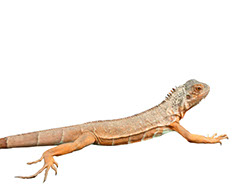 Red Iguana | 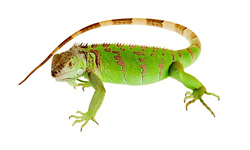 Green Iguana |
Bileog Cúram Iguana
Méid: raon iguanas Fásta i méid 4-6 troigh ar fhad.
Tréimhse saoil: Má chúram cuí do, ba cheart iguanas beo níos mó ná 20 bliain i mbraighdeanas.
Tá iguanas cad a cheapann daoine is mó de nuair a cheapann siad: cuma ginearálta 'laghairt.' Tá siad cúig toes ar gach shiúl na gcos. Bhfuil siad flap méithe de craiceann faoi na smig dtugtar dewlap. Tá gach iguanas spíoin go ritheann fad na ais. Murab ionann creideamh an phobail, nach bhfuil gach iguanas glas. An chuid is mó ógánaigh geal glas, ach de réir mar théann siad in aois agus ag fás is féidir leo raon i dath ó glas dull go oráiste donn nó fiú le eireabaill striped.
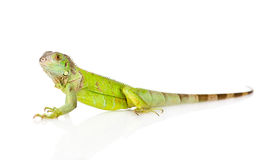
Riachtanais tithíochta
Is é an imfhálú do iguana fásta an-mhór: Imfhálú. Ba chóir an imfhálú a bheith ar a laghad sé troigh ar airde, thart ar 1
Teocht: iguanas teacht ó aeráid teochreasach agus is gá chun a choinneáil te. Ba chóir go mbeadh teocht an lae 80.
Teas / Solas: Tá Ultraviolet soilsiú fáil UVA agus UVB teastáil le haghaidh metabolism cailciam chuí agus forbairt skeletal. Gan an soilsiú cuí a bheidh do bheith breoite agus bás a bás an-painful. Is féidir soilsiú cuí a chur ar fáil ag baint úsáide as feadáin fluaraiseacha déanta go speisialta lena n-úsáid ag reiptílí, chomh maith le bolgáin gaile mearcair a chur ar fáil freisin roinnt teas chomh maith. Is féidir teas breise a chur ar fáil ag baint úsáide as hastaírí ceirmeacha infridhearg agus bolgáin ghealbhruthacha basking. Níor chóir carraigeacha te a úsáid faoi aon imthoisc is féidir leo a dhó mór do iguana.

Tsubstráit: Beidh iguanas minic lick teanga a dtimpeallacht. Mar gheall ar an tsubstráit cáithníneach mó (scamh adhmaid, móta, gaineamh, nó cineálacha púdar) nach bhfuil oiriúnach don chuid is mó iguanas. Nuachtán le dúch neamh-tocsaineach, páipéar búistéir, tuáillí páipéir, carpeting dhíon / amuigh faoin aer, nó féir saorga a dhéanamh ar gach roghanna den scoth. Má ag baint úsáide carpeting dhíon / amuigh faoin aer nó féir saorga thoil a bheith cinnte nach bhfuil aon teaghráin dangling a d'fhéadfadh tangle i tairní do iguana ar. Tá sé molta freisin go bhfuil tú píosaí éagsúla ionas gur féidir leat a chur in ionad na píosaí salach leis an leagan glan agus ansin glan agus disinfect an leagan atá ann faoi láthair a úsáid le haghaidh an glanadh chugainn.
Environment: Iguanas come from a tropical climate and require a humidity level of 65% to 75%. To achieve this may require several misting’s a day. Many people opt to purchase an automatic misting system instead.
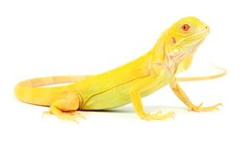
Diet: Iguanas are strict herbivores. Many older literatures will suggest feeding animal protein or even cat food. While some wild iguanas may ingest the occasional insect while eating leaves, it is not a significant portion on their diet. Iguanas that are fed too much animal protein will develop health problems and will die prematurely. A well balanced iguana diet will consist of about 40% to 45% greens (this includes, but is not limited to collard greens, turnip greens, mustard greens, dandelion greens (with flowers), escarole, and/or water cress), 40% to 45% other vegetables (this includes but is not limited to green beans, orange-fleshed squashes (butternut, Kabocha), snap or snow peas, parsnip, asparagus, okra, alfalfa (mature, not sprouts), onions, mushrooms, bell peppers, sweet potato, zucchini, yellow squash, and/or carrots), 10% or less of fruits (including, but not limited to Figs (raw or dried), blackberries, strawberries, raspberries, grapes, mango, melon (cantaloupe, honeydew, watermelon), papaya, banana, and/or apple), and less than 5% of other grains or commercial diets. Iguanas should never be rhubarb as it is toxic. Certain lettuces such as iceberg, romaine, and Boston butter lack sufficient nutrients and should only be fed occasionally. Acidic fruits (citrus, tomatoes, kiwi, pineapples, etc.) should also be only fed occasionally as well. Tofu can be occasionally offered as well for supplemental protein, though if too much is given it can lead to long term health issues. Wild plants and flowers are not recommended since they may be toxic to your iguana or may contain pesticides that could be toxic as well.
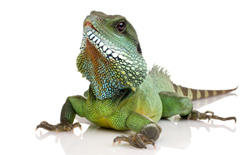
Maintenance: Cleanliness of the enclosure is essential. Waste products should be removed daily and the enclosure should be thoroughly cleaned and disinfected regularly. A 5% bleach solution provides an excellent disinfectant. Be sure to thoroughly rinse the solution from the enclosure before placing the iguana back in. Fresh water should also be offered at all times. Always wash your hands after handling your iguana or any of your iguana\'s cage accessories.